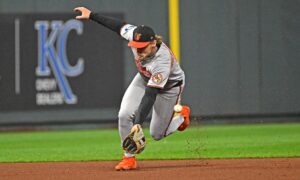SCROLL DOWN TO READ ARTICLE

If asked to name the first World Series game played in Baltimore, many Oriole fans would cite Game 3 of the 1966 Series at Memorial Stadium when Wally Bunker beat the Los Angeles Dodgers, 1-0.
But no, I’m afraid that’s not it.
Well, then, fans of the “Old Time” O’s may think back to the first game of the fabled Temple Cup Series on October 4, 1894 when the New York Giants beat the Orioles, 4-1, at Union Park on 25th Street.
But no, that’s not it, either.
CONTINUE READING BELOW
Believe it or not, the first World Series game played in Baltimore did not even involve a Baltimore team — it was the 11th game (yes, that’s right, the 11th game) of the 1887 World Series between the champions of the two professional leagues at that time — the National League Detroit Wolverines and the American Association St. Louis Browns. That game was played at Oriole Park, just east of Charles Village.
These two teams engaged in a World Series unlike any other. What makes this Series unique? It was a 15-game World Series, and it was played in an astounding 10 different ballparks in 9 different cities during a 17-day stretch.
| Date | Location | Score | |
| Game 1 | Oct. 10 | Sportsman’s Park (STL) | STL 6 DET 1 |
| Game 2 | Oct. 11 | Sportsman’s Park (STL) | DET 5 STL 3 |
| Game 3 | Oct. 12 | Recreation Park (DET) | DET 2 STL 1 |
| Game 4 | Oct. 13 | Recreation Park (PITT) | DET 8 STL 0 |
| Game 5 | Oct. 14 | Washington Park (BKL) | STL 5 STL 2 |
| Game 6 | Oct. 15 | Polo Grounds (NYC) | DET 9 STL 0 |
| Game 7 | Oct. 17 | Baseball Grounds (PHILA) | DET 3 STL 1 |
| Game 8 | Oct. 18 | South Side Grounds (BOS) | DET 9 STL 2 |
| Game 9 | Oct. 19 | Baseball Grounds (PHILA) | DET 4 STL 2 |
| Game 10 | Oct. 21 | Swampoodle Grounds (WASH) | STL 11 DET 4 |
| Game 11 | Oct. 21 | Oriole Park (BAL) | DET 13 STL 3 |
| Game 12 | Oct. 22 | Washington Park (BKL) | STL 5 DET 1 |
| Game 13 | Oct. 24 | Recreation Park (DET) | DET 6 STL 3 |
| Game 14 | Oct. 25 | West Side Park (CHI) | DET 4 STL 3 |
| Game 15 | Oct. 26 | Sportsman’s Park (STL) | STL 9 DET 2 |
Even more remarkably, on October 21 these teams played in two different cities — the first and only World Series doubleheader. This was necessitated by a rainout, resulting in a game played in the morning at Washington’s Swampoodle Grounds (the current location of Union Station and the National Postal Museum), and a second game in Baltimore at 3 p.m.
It was cold and windy that day in Baltimore, but the 2,707 lucky fans got to see four future Hall of Famers in action: For St. Louis, first baseman and baseball pioneer Charles Comiskey, and for Detroit, centerfielder Ned Hanlon, rightfielder Sam Thompson, and catcher Deacon White. Detroit’s 13-3 victory was the clinching game of the series, but the teams still went on to play the remaining scheduled games, resulting in a 10-5 Series win for the Wolverines.
Undoubtedly, the player that day who would prove to be the most historically significant was Hanlon. In 13 seasons as a player, he accumulated 1,318 hits and was renowned for his defense and base-stealing prowess.
CONTINUE READING BELOW
Hanlon would garner greater fame in Baltimore and beyond by becoming one of baseball’s most influential managers, inventing and/or refining a style of play that became known as “Inside” or “Scientific” baseball.
An astute judge of talent, he engineered many productive trades that would earn him the nickname “Foxy Ned.” He would lead the 1890s Orioles to three consecutive NL pennants, win two Temple Cup Championships, and then two NL pennants with the Brooklyn Superbas (aka the Dodgers). After being named the Orioles’ manager in 1892, Hanlon lived out the remaining 45 years of his life in Baltimore and was inducted into the Hall of Fame in 1996 in the same class as Baltimore’s other great manager, Earl Weaver.
Detroit would soon end up in financial straits and fold after the 1888 season, and the city would not field a major league team again until the 1901 when the Tigers joined the new American League.
Detroit would not win another World Series until 1935, although before then they would win four AL pennants. The Browns would win their fourth straight AA title the next season, then join the NL in 1892 and be renamed the St. Louis Cardinals in 1900. They would not win another pennant until 1926 when they beat Babe Ruth and the mighty Yankees in another of the more memorable World Series.
Tom Delise grew up in New York as a Mets fan and Yankee hater, and to this day, Tom Seaver is his baseball hero. He has lived in Baltimore for 34 years and has held season tickets for the Orioles since 1992 and the Ravens since they moved here. He retired in 2018 after a 40-year career as an English teacher and now spends much of his time reading, especially about “old time” baseball. He lives in the Bolton Hill section of Baltimore with his wife Christine and his dogs Shakespeare and Cordelia.
Jack Gibbons spent 46 years in sports journalism, including a chunk of that time as sports editor of The Baltimore Sun. Now retired from full-time work, Jack serves as the lead editor and writer for BaltimoreBaseball.com’s Calling the Pen, a periodic feature that highlights baseball essays written by the community. If you would like to contribute to Calling the Pen, send a 750-1,200-word, original piece via email to jack@baltimorebaseball.com for consideration.
7 Comments
You must be logged in to post a comment Login or Register Here
Leave a Reply
You must be logged in to post a comment.










